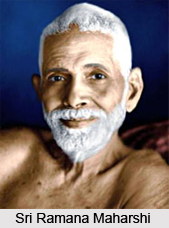 Sri Ramana Maharshi was an Indian spiritual leader of 19th century. At the age of sixteen he left home for Arunachala. In spite of being a Brahmin he declared himself an "Atiasrami", a Sastraic state of non-attachment to anything in life. Sri Ramana was born in Tiruchuli, Madurai district in Tamil Nadu, on Arudra Darshanam day, into an orthodox Hindu Tamil family to Sundaram Iyer and Azhagammal. He was the second of four children of his parents. He was named Venkataraman at birth. His siblings were Nagaswamy (1877-1900), Nagasundaram (1886-1953) and sister Alamelu (1891/92-1953).
Sri Ramana Maharshi was an Indian spiritual leader of 19th century. At the age of sixteen he left home for Arunachala. In spite of being a Brahmin he declared himself an "Atiasrami", a Sastraic state of non-attachment to anything in life. Sri Ramana was born in Tiruchuli, Madurai district in Tamil Nadu, on Arudra Darshanam day, into an orthodox Hindu Tamil family to Sundaram Iyer and Azhagammal. He was the second of four children of his parents. He was named Venkataraman at birth. His siblings were Nagaswamy (1877-1900), Nagasundaram (1886-1953) and sister Alamelu (1891/92-1953).
Spiritual Realisation of Sri Ramana Maharshi
From the age of eleven Venkataraman was brought up by his uncle. Venkataraman had a life changing experience, soon after, in mid-July 1896, at the age of sixteen. For him at the early age ego mattered a lot. It was the only real thing about his being. After he realised what Moksha was young Venkataraman found himself on the acme of spirituality. In the flood of Self-awareness the ego was lost. Happening unexpectedly the boy that used to be called Venkataraman had bloomed into a sage and saint. Utter indifference had grown up into him to his surroundings. Humility, humbleness, non-resistance and other qualities became his ornamentation. The new vision was perpetually with him and He began to live the spiritualized life.
Devout life of Sri Ramana Maharshi
Venkataraman decided to leave his home and go to Arunachala. After wandering for a considerable span, on the morning of the 1st of September (now observed as Advent Day), 1896, he boarded the train and travelled the remaining distance to reach Tiruvannamalai district. After getting down from the train at Tiruvannamalai he went straight to the temple of Arunachaleshwara.
Ramana shifted his residence a little less than six months after his arrival at Tiruvannamalai to a shrine called Gurumurtam. After about a year`s stay at Gurumurtam, the Swami moved to an adjacent mango orchard.
In February of 1899, Sri Ramana moved further up Arunachala. In 1916 his mother Alagammal and younger brother Nagasundaram joined Sri Ramana at Tiruvannamalai and they both took `sannyasin`. Nagasundaram assumed the name Niranjanananda became known as Chinnaswami. Sri Ramana composed `The Five Hymns to Arunachala` during this period, his work of art in devotional lyric poetry. Of them the first is `Akshara Mana Malai`.
On 14th April 1950, Sri Ramana passed away.
Teachings of Sri Ramana Maharshi
Sri Ramana taught about self-enquiry. It is the practice with which he is most widely associated with. These teachings, among the Indian schools of thought, have been classified as the Path of Knowledge (Jnana marga). Though his teaching is coherent with and broadly tied in with Hinduism, the Upanishads and Advaita Vedanta, there are some differences with the traditional Advaitic School. Sri Ramana gave his consent to a variety of these paths and practices from various religions. His soonest teachings are substantiated in the w (Who am I), originally written in Tamil.
Sri Ramana has also counselled against considering self enquiry as an intellectual exercise. He was also known to have advised the practice of Bhakti and self surrender. The traditional Advaitic schools of thought pioneered by Sri Sankaracharya and teachings of Sri Ramana have many things in common.




















